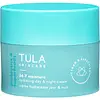What's inside
What's inside
 Key Ingredients
Key Ingredients

 Benefits
Benefits

 Concerns
Concerns

 Ingredients Side-by-side
Ingredients Side-by-side

Water
Skin ConditioningButylene Glycol
HumectantEthylhexyl Palmitate
EmollientSqualane
EmollientGlycerin
HumectantCetyl Alcohol
EmollientCaprylic/Capric Triglyceride
MaskingDimethicone
EmollientHydrogenated Vegetable Oil
EmollientGlyceryl Stearate
EmollientPEG-100 Stearate
Bifida Ferment Lysate
Skin ConditioningLactose
HumectantLactis Proteinum
Skin ConditioningYogurt Extract
Skin ConditioningHydrolyzed Rice Protein
Skin ConditioningCichorium Intybus Root Extract
MaskingVaccinium Angustifolium Fruit Extract
Skin ProtectingVegetable Oil
Skin ConditioningCamelina Sativa Seed Oil
Skin ConditioningCamellia Sinensis Leaf Extract
AntimicrobialCurcuma Longa Root Extract
MaskingTocopheryl Acetate
AntioxidantAscorbyl Palmitate
AntioxidantCarthamus Tinctorius Seed Oil
MaskingOlea Europaea Fruit Oil
MaskingPyrus Malus Fruit Extract
Skin ConditioningCitrullus Lanatus Fruit Extract
Skin ConditioningLens Esculenta Fruit Extract
Skin ConditioningSodium Lactate
BufferingSodium PCA
HumectantCarbomer
Emulsion StabilisingSodium Hydroxide
BufferingPentylene Glycol
Skin ConditioningCaprylyl Glycol
EmollientBulnesia Sarmientoi Wood Oil
MaskingCitrus Limon Fruit Oil
AstringentCitrus Aurantium Dulcis Oil
MaskingJuniperus Mexicana Oil
MaskingCananga Odorata Flower Oil
MaskingEthylhexylglycerin
Skin ConditioningStearyl Alcohol
EmollientDisodium EDTA
Citric Acid
BufferingSorbic Acid
PreservativePhenethyl Alcohol
MaskingSodium Benzoate
MaskingPotassium Sorbate
PreservativePhenoxyethanol
PreservativeParfum
MaskingAlpha-Isomethyl Ionone
PerfumingButylphenyl Methylpropional
PerfumingLinalool
PerfumingHexyl Cinnamal
PerfumingWater, Butylene Glycol, Ethylhexyl Palmitate, Squalane, Glycerin, Cetyl Alcohol, Caprylic/Capric Triglyceride, Dimethicone, Hydrogenated Vegetable Oil, Glyceryl Stearate, PEG-100 Stearate, Bifida Ferment Lysate, Lactose, Lactis Proteinum, Yogurt Extract, Hydrolyzed Rice Protein, Cichorium Intybus Root Extract, Vaccinium Angustifolium Fruit Extract, Vegetable Oil, Camelina Sativa Seed Oil, Camellia Sinensis Leaf Extract, Curcuma Longa Root Extract, Tocopheryl Acetate, Ascorbyl Palmitate, Carthamus Tinctorius Seed Oil, Olea Europaea Fruit Oil, Pyrus Malus Fruit Extract, Citrullus Lanatus Fruit Extract, Lens Esculenta Fruit Extract, Sodium Lactate, Sodium PCA, Carbomer, Sodium Hydroxide, Pentylene Glycol, Caprylyl Glycol, Bulnesia Sarmientoi Wood Oil, Citrus Limon Fruit Oil, Citrus Aurantium Dulcis Oil, Juniperus Mexicana Oil, Cananga Odorata Flower Oil, Ethylhexylglycerin, Stearyl Alcohol, Disodium EDTA, Citric Acid, Sorbic Acid, Phenethyl Alcohol, Sodium Benzoate, Potassium Sorbate, Phenoxyethanol, Parfum, Alpha-Isomethyl Ionone, Butylphenyl Methylpropional, Linalool, Hexyl Cinnamal
Vitis Vinifera
MaskingAloe Barbadensis Leaf Juice
Skin ConditioningCetearyl Alcohol
EmollientButyrospermum Parkii Butter
Skin ConditioningGlycerin
HumectantCetearyl Glucoside
EmulsifyingSimmondsia Chinensis Seed Oil
EmollientOenothera Biennis Oil
EmollientLinum Usitatissimum Seed Oil
PerfumingBorago Officinalis Seed Oil
EmollientLimnanthes Alba Seed Oil
Skin ConditioningGluconolactone
Skin ConditioningSodium Benzoate
MaskingSorbitan Stearate
EmulsifyingMagnesium Ascorbyl Phosphate
AntioxidantTocopherol
AntioxidantSodium Hyaluronate
HumectantCalendula Officinalis Extract
Skin ConditioningChamomilla Recutita Extract
Skin ConditioningTilia Cordata Extract
RefreshingCoenochloris Signiensis Extract
Skin ConditioningPotassium Sorbate
PreservativeCopernicia Cerifera Wax
Litsea Cubeba Fruit Oil
MaskingCananga Odorata Leaf Oil
MaskingOlibanum
MaskingCommiphora Myrrha Oil
MaskingVitis Vinifera, Aloe Barbadensis Leaf Juice, Cetearyl Alcohol, Butyrospermum Parkii Butter, Glycerin, Cetearyl Glucoside, Simmondsia Chinensis Seed Oil, Oenothera Biennis Oil, Linum Usitatissimum Seed Oil, Borago Officinalis Seed Oil, Limnanthes Alba Seed Oil, Gluconolactone, Sodium Benzoate, Sorbitan Stearate, Magnesium Ascorbyl Phosphate, Tocopherol, Sodium Hyaluronate, Calendula Officinalis Extract, Chamomilla Recutita Extract, Tilia Cordata Extract, Coenochloris Signiensis Extract, Potassium Sorbate, Copernicia Cerifera Wax, Litsea Cubeba Fruit Oil, Cananga Odorata Leaf Oil, Olibanum, Commiphora Myrrha Oil
 Reviews
Reviews

Ingredients Explained
These ingredients are found in both products.
Ingredients higher up in an ingredient list are typically present in a larger amount.
Glycerin is already naturally found in your skin. It helps moisturize and protect your skin.
A study from 2016 found glycerin to be more effective as a humectant than AHAs and hyaluronic acid.
As a humectant, it helps the skin stay hydrated by pulling moisture to your skin. The low molecular weight of glycerin allows it to pull moisture into the deeper layers of your skin.
Hydrated skin improves your skin barrier; Your skin barrier helps protect against irritants and bacteria.
Glycerin has also been found to have antimicrobial and antiviral properties. Due to these properties, glycerin is often used in wound and burn treatments.
In cosmetics, glycerin is usually derived from plants such as soybean or palm. However, it can also be sourced from animals, such as tallow or animal fat.
This ingredient is organic, colorless, odorless, and non-toxic.
Glycerin is the name for this ingredient in American English. British English uses Glycerol/Glycerine.
Learn more about GlycerinPotassium Sorbate is a preservative used to prevent yeast and mold in products. It is commonly found in both cosmetic and food products.
This ingredient comes from potassium salt derived from sorbic acid. Sorbic acid is a natural antibiotic and effective against fungus.
Both potassium sorbate and sorbic acid can be found in baked goods, cheeses, dried meats, dried fruit, ice cream, pickles, wine, yogurt, and more.
You'll often find this ingredient used with other preservatives.
Learn more about Potassium SorbateSodium Benzoate is a preservative. It's used in both cosmetic and food products to inhibit the growth of mold and bacteria. It is typically produced synthetically.
Both the US FDA and EU Health Committee have approved the use of sodium benzoate. In the US, levels of 0.1% (of the total product) are allowed.
Sodium benzoate works as a preservative by inhibiting the growth of bacteria inside of cells. It prevents the cell from fermenting a type of sugar using an enzyme called phosphofructokinase.
It is the salt of benzoic acid. Foods containing sodium benzoate include soda, salad dressings, condiments, fruit juices, wines, and snack foods.
Studies for using ascorbic acid and sodium benzoate in cosmetics are lacking, especially in skincare routines with multiple steps.
We always recommend speaking with a professional, such as a dermatologist, if you have any concerns.
Learn more about Sodium Benzoate